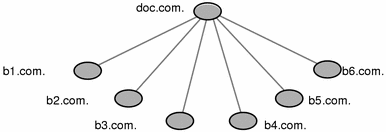Organizational or Geographical Mapping
One of the major benefits of NIS+ is its capability of dividing the namespace into smaller, more manageable parts. You could create a hierarchy of organizations, such as those of the hypothetical corporation, Doc Inc., as shown in Figure 2-2
Figure 2-2 Sample NIS+ Hierarchy by Logical Organization

You could also organize the hierarchy by buildings instead of organizations, as shown in Figure 2-3.
Figure 2-3 Sample NIS+ Hierarchy by Physical Location

The scheme you select depends primarily on how you prefer to administer the namespace and how clients will tend to use the namespace. For example, if clients of factory.com. will be distributed throughout the buildings of Doc Inc., you should not organize the namespace by building. Because the clients constantly need to have access to other domains, you need to add their credentials to the other domains and you increase traffic flow through the root master server. A better scheme would be to arrange clients by organization. On the other hand, building-sized domains are immune to the reorganizations that require organization-based domains to be restructured.
Do not be limited by the physical layout of the network; an NIS+ namespace does not have to be congruent with the physical network, except where it has to support NIS clients. The number of domains your namespace needs depends on the kind of hierarchy you select.
Consider future expansion plans. Will today's NIS+ root domain be beneath another NIS+ domain in the future? Changing this arrangement would entail a great deal of work. Try to estimate the need for future domains in the namespace and design a structure that can accommodate them without disruption.
- © 2010, Oracle Corporation and/or its affiliates
